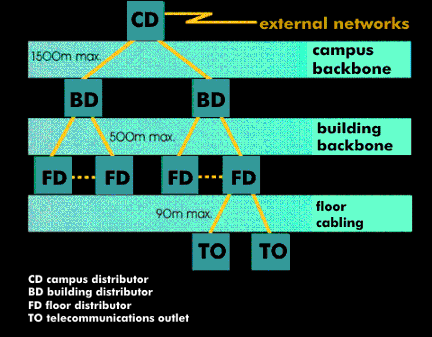EIA/TIA 568
The umbrella organizations Electronics Industry Association(EIA) and Telecommunications Industry Association( TIA) started standardization activities for universal building cabling for the USA as early as 1985. In July 1991, the work was published under the title "Commercial Building Telecommunications Wiring Standard" EIA/TIA 568 and formed the first standard for structured cabling of buildings with data and telecommunications services.
After the standard was revised in 1993, the new version ANSI/TIA/EIA 568A became the basis for building wiring in North America in October 1995 in conjunction with its supplements TSB-36 (1991), TSB-40 (1992), TSB-53 (1995), and TSB-67(1995). The EIA/TIA 568A standard differs, in some cases seriously, from the ISO/IEC11801 and EN 50173 standards.
Structured cabling under EIA/TIA 568A.
EIA/TIA 568A structures cabling into the areas that are relevant for large enterprises: Namely, the campus, which is the primary area; the building, which is the secondary area; and the floor, which is the tertiary area. The EIA/TIA standard specifies length restrictions for each individual area, as well as the topology to be created and recommendations for the cable types to be installed.
According to the areas, the cabling to be implemented is called premises cabling, building cabling and floor cabling. The scope of the standard ends at the telecommunications junction box.
The first version of EIA/TIA Standard 568 proposed the following cable types for building and floor cabling: 62.5/125 µm gradient fiber, 50-ohm coaxial cable, 150-ohm STP and 100-ohm UTP cable. The standard does not recognize shielded 100-ohm cable. TP cables are divided into five categories; three are for data transmission applications, and two are for analog and digital telephone communications. The standard stipulates that there must basically be two copper-based information paths to each workstation: one for the telephone, the other for data transmission.
The transmission parameters of balanced cables are defined in five categories, with cable specifications improving as the category increases. Thus, a category 1 cable, is a low-cost cable for analog voice transmission and transmission at bit rates much lower than 1 Mbps. A Category 2 cable for transmissions of bit rates up to 4 Mbit/s, a Category 3 cable for transmissions of bit rates up to 10 Mbit/s, for bit rates up to 20 Mbit/s is the Category 4 cable, and a Category 5 cable reaches up to 100 MHz.

